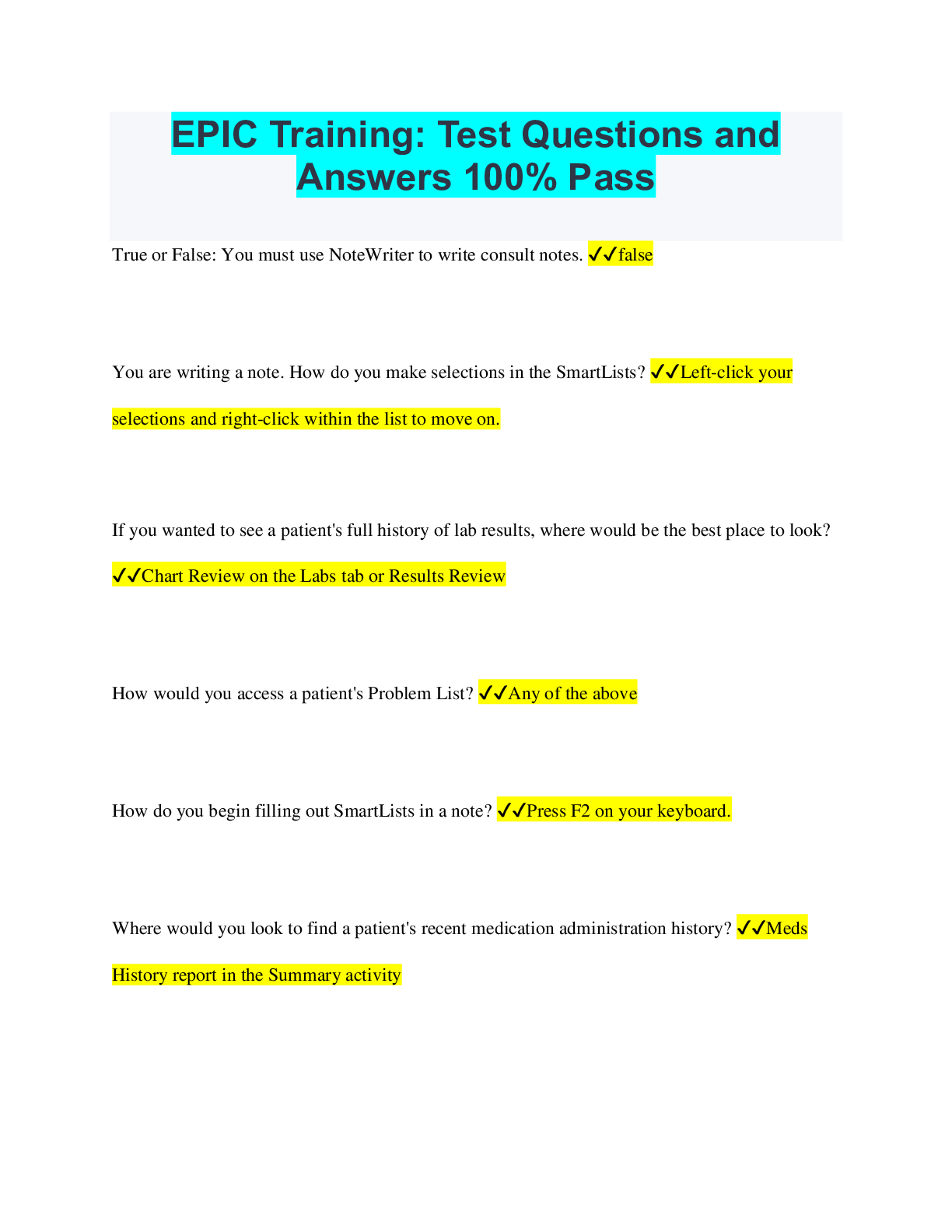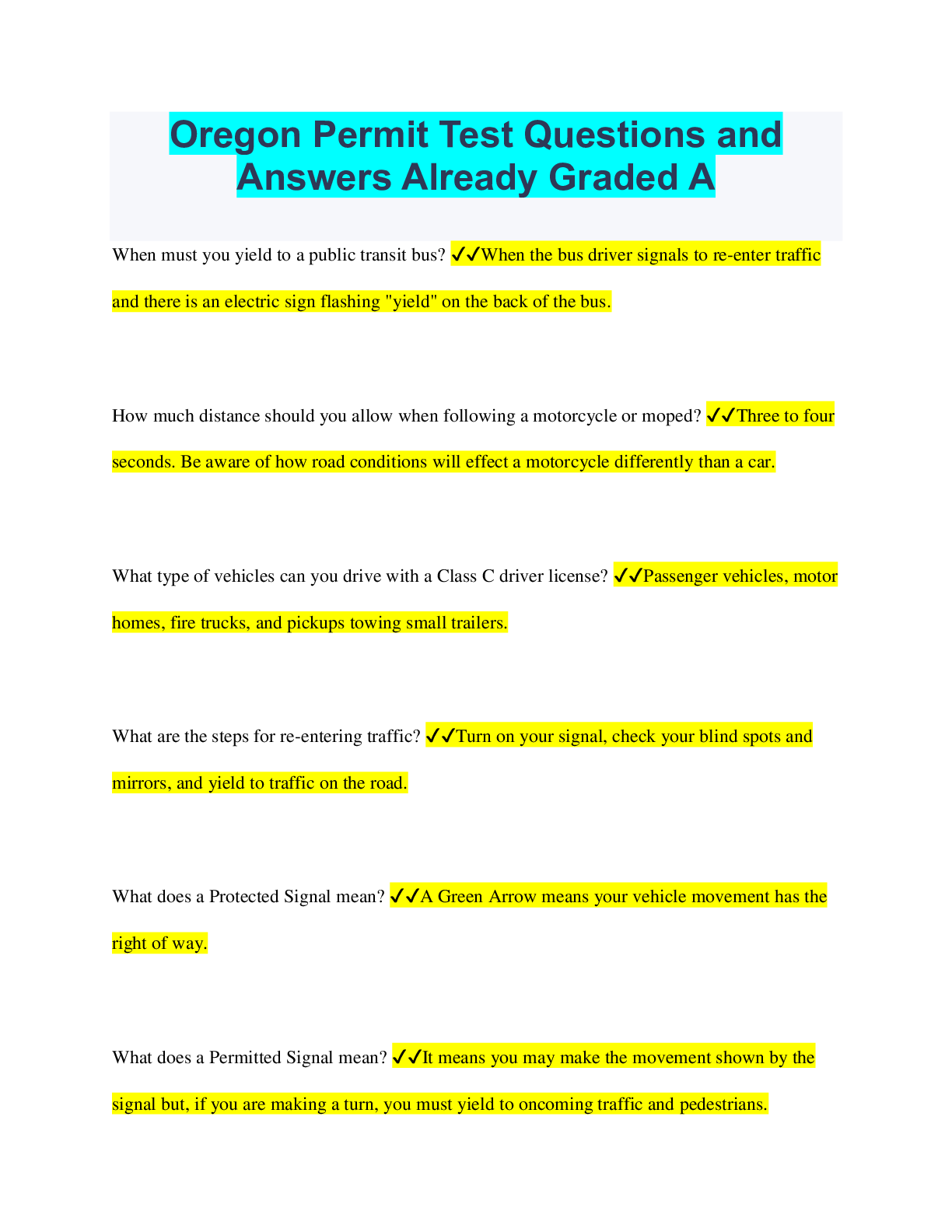*NURSING > QUESTIONS & ANSWERS > NR 508 Week 4 Mid-term Exam-Chamberlain College Of Nursing: SATISFACTION GUARANTEED (All)
NR 508 Week 4 Mid-term Exam-Chamberlain College Of Nursing: SATISFACTION GUARANTEED
Document Content and Description Below
A primary care NP prescribes levothyroxine for a patient to treat thyroid deficiency. When teaching this patient about the medication, the NP should: tell the patient that changing brands of the med... ication should be avoided. Patients should be told not to change brands of the medication; there is potential variability in the bioequivalence between manufacturers. The medication should be taken at approximately the same time each day before breakfast or on an empty stomach. Patients should be instructed to contact the provider if signs of thyrotoxicosis are present. Thyroid replacement medications are usually given for life. An African-American patient is taking captopril (Capoten) 25 mg twice daily. When performing a physical examination, the primary care nurse practitioner (NP) learns that the patient continues to have blood pressure readings of 135/90 mm Hg. The NP should: add a thiazide diuretic to this patient's regimen Some African-American patients do not appear to respond as well as whites in terms of blood pressure reduction. The addition of a low-dose thiazide diuretic often allows for efficacy in blood pressure lowering that is comparable with that seen in white patients. Increasing the captopril dose is not indicated. Losartan is an angiotensin receptor blocker (ARB) and is not indicated in this case. A primary care NP sees a patient who is about to take a cruise and reports having had motion sickness with nausea on a previous cruise. The NP prescribes the scopolamine transdermal patch and should instruct the patient to apply the patch: every 3 days. The transdermal system allows steady-state plasma levels of scopolamine to be reached rapidly and maintained for 3 days. The onset of action is approximately 4 hours. The patch should be changed every 3 days and left on at all times, not as needed A 12-year-old patient who is obese develops type 2 diabetes mellitus. The primary care NP should order metformin (Glucophage). Metformin is the only drug listed that is recommended for children A patient who has had four to five liquid stools per day for 4 days is seen by the primary care NP. The patient asks about medications to stop the diarrhea. The NP tells the patient that antidiarrheal medications are: not curative and may prolong the illness Treatment of patients with acute diarrhea with antidiarrheals can prolong infection and should be avoided if possible. Antidiarrheals are best used in patients with mild to moderate diarrhea and are used for comfort and not cure. They should not be used for patients with bloody diarrhea or high fever because they can worsen the disease. Prolonged diarrhea can indicate a more serious cause, and antidiarrheals should not be used in those cases. In every state, prescriptive authority for NPs includes the ability to write prescriptions for specified classifications of medications. All states now have some degree of prescriptive authority granted to NPs, but not all states allow authority to prescribe controlled substances. Many states still require some degree of physician involvement with certain types of drugs. A 55-year-old woman has a history of myocardial infarction (MI). A lipid profile reveals LDL of 130 mg/dL, HDL of 35 mg/dL, and triglycerides 150 mg/dL. The woman is sedentary with a body mass index of 26. The woman asks the primary care NP about using a statin medication. The NP should: begin therapy with atorvastatin 10 mg per day This woman would be using a statin medication for secondary prevention because she already has a history of MI, so a statin should be prescribed. Dietary and lifestyle changes should be a part of therapy, but not the only therapy. She is relatively young, and quality-of-life issues are not a concern. There is no clinical evidence to support use of statins as primary prevention in women. A patient develops hypertension. The primary care nurse practitioner (NP) plans to begin diuretic therapy for this patient. The NP notes clear breath sounds, no organomegaly, and no peripheral edema. The patient's serum electrolytes are normal. The NP should prescribe: hydrochlorothiazide (HydroDIURIL) Thiazide diuretics are first-line drugs for treating hypertension. The other three drugs are not thiazide diuretics The primary care nurse practitioner (NP) is using critical thinking skills when analyzing current research and synthesizing new approaches to patient care. Practitioners use critical thinking skills by reviewing and analyzing current knowledge and synthesizing approaches to apply to unique patient situations. Using standardized protocols, adhering to scientific principles, and following practices of seasoned mentors may be useful, but these do not encompass the concept of critical thinking, which requires the practitioner to use what is known in new situations. A patient comes to the clinic and asks the primary care NP about using a newly developed formulation of the drug the patient has been taking for a year. When deciding whether or not to prescribe this formulation, the NP should: tell the patient that when postmarketing data is available, it will be considered. About 6 to 12 months of postmarketing experience can yield information about drug efficacy and side effects, so patients should be cautioned to wait for these data. Drug company promotional materials have biased information. Most new drugs are more expensive, and costs alone should not determine drug choice. Extended-release forms are often more expensive. A patient takes a cardiac medication that has a very narrow therapeutic range. The primary care NP learns that the particular brand the patient is taking is no longer covered by the patient's medical plan. The NP knows that the bioavailability of the drug varies from brand to brand. The NP should: contact the insurance provider to explain why this particular formulation is necessary. In this case, the NP should advocate for the desired drug because changing the drug can have lifethreatening consequences. If this fails, other options may have to be explored. In this case, the NP should advocate for the desired drug because changing the drug can have lifethreatening consequences. If this fails, other options may have to be explored. bismuth subsalicylate (Pepto-Bismol) Bismuth reduces symptoms through antidiarrheal and antibacterial properties and can decrease nausea and vomiting. Opioid antidiarrheals should be given after the cause of infectious diarrhea is treated; these can actually prolong symptoms because they slow transit of the causative organisms through the gut. Attapulgite can be used because it binds bacteria and toxins in the gastrointestinal tract, but bismuth is a better choice in this case because it helps to treat nausea. The patient is drinking Gatorade and is getting electrolyte replacement. To increase the likelihood of successful pharmacotherapy, when teaching a patient about using a medication, the primary care nurse practitioner (NP) should: encourage the patient to participate in the choice of the medication. It is important that the patient "owns the problem" and has a part in the solution. Providing education about the medication, stressing the importance of following medication instructions, and distributing package inserts may be useful, but it is essential that patients take an active role in their care. A patient in the clinic develops sudden shortness of breath and tachycardia. The primary care NP notes thready pulses, poor peripheral perfusion, and a decreased level of consciousness. The NP activates the emergency medical system and should anticipate that this patient will receive: unfractionated heparin (UFH) and warfarin OR Alteplase This patient has unstable pulmonary embolism (PE) and should receive thrombolytic therapy. Intravenous alteplase is the preferred agent. UFH and warfarin are recommended for stable PE. LMWH is beneficial in submassive PE and deep vein thrombosis (DVT) but is controversial for treatment of massive PE. A primary care nurse practitioner (NP) prescribes a drug to an 80-year-old African-American woman. When selecting a drug and determining the correct dose, the NP should understand that the knowledge of how age, race, and gender may affect drug excretion is based on an understanding of: pharmacokinetics Pharmacokinetics is the study of the action of drugs in the body and may be thought of as what the body does to the drug. Factors such as age, race, and gender may change the way the body acts to metabolize and excrete a drug. Bioavailability refers to the amount of drug available at the site of action. Pharmacodynamics is the study of the effects of drugs on the body. Anatomy and physiology is a basic understanding of how the body functions. An 80-year-old female patient with a history of angina has increased TSH and decreased T4. The primary care NP should prescribe _____ mcg of _____. 25; levothyroxine Elderly individuals may experience exacerbation of cardiovascular disease and angina with thyroid hormone replacement. It is advisable to start low at 25 mcg and work up as tolerated. Liothyronine is a synthetic T3. A patient who has a history of chronic constipation uses a bulk laxative to prevent episodes of acute constipation. The patient reports having an increased frequency of episodes. The primary care NP should recommend: adding docusate sodium (Colace). Patients treated for long-term constipation should begin with a bulk laxative. If that is not effective, the addition of a second laxative may be necessary. Using two laxatives from the same category is not recommended. A stool softener, such as docusate sodium, is appropriate. Bisacodyl is not a second-line treatment. Lactulose and polyethylene glycol are from the same category. A patient comes to the clinic to discuss weight loss. The primary care NP notes a BMI of 32 and performs a health risk assessment that reveals no obesity-related risk factors. The NP should recommend: changes in diet and exercise along with short-term phentermine. This patient is grade 2 overweight (obese), so a short-term course of phentermine is useful, especially as there are no cardiovascular risk factors. Orlistat is a second-line drug. Surgical intervention is indicated when other therapies fail. Changes in diet and physical activity alone do not bring immediate results, and patients often get discouraged. A primary care NP sees a 3-year-old [Show More]
Last updated: 2 years ago
Preview 1 out of 15 pages

Buy this document to get the full access instantly
Instant Download Access after purchase
Buy NowInstant download
We Accept:

Reviews( 0 )
$13.00
Can't find what you want? Try our AI powered Search
Document information
Connected school, study & course
About the document
Uploaded On
Apr 24, 2022
Number of pages
15
Written in
Additional information
This document has been written for:
Uploaded
Apr 24, 2022
Downloads
0
Views
89

.png)
















